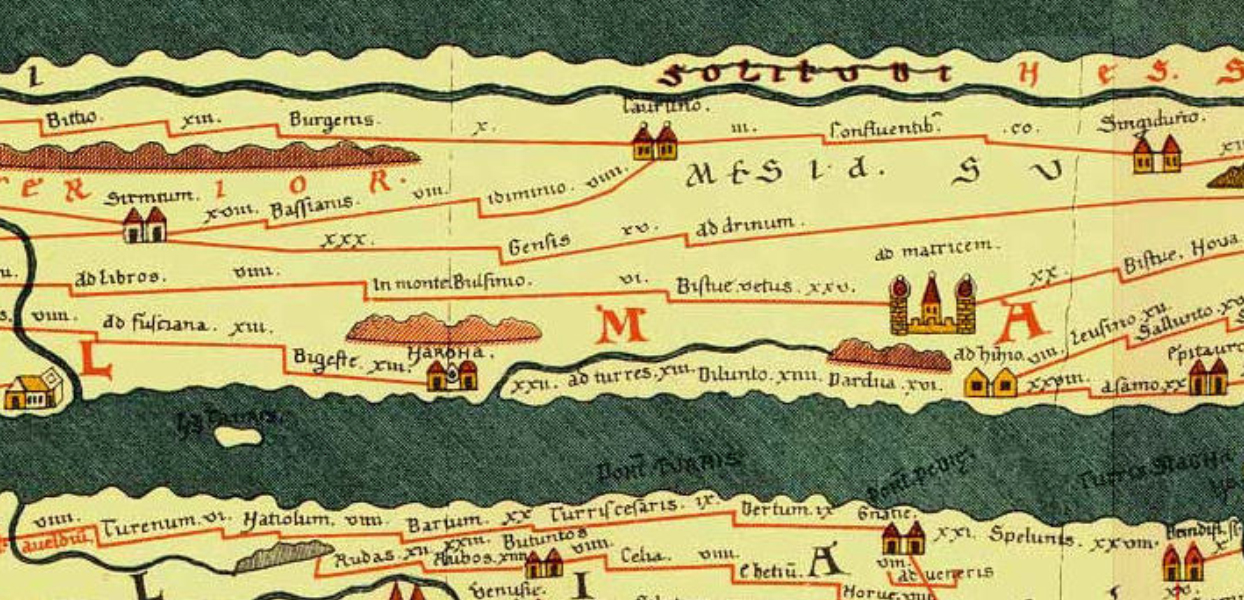|
Vidin Grad
Vidin Grad was a fortress, located at the top of the Vidojevica hill, near village Lešnica, municipality of Loznica, Today, little remain of fortification walls and towers which are spreading on the top of the hill, on a plateau with rough dimensions of 50 m diameter. From it, the terrain steep drops on all sides to dry ditch, which is spreading around the entire fortress to protected the access to it. Remains of walls, made of roughly trimmed stone, are largely covered with vegetation, and their original thickness is estimated at 100 cm. They were reinforced with at least two towers, whose ruins can be seen on the ground. See also * Koviljkin grad * Trojanov Grad * Gensis (vicus) References * Aleksandar Deroko, "Medieval cities in Serbia, Montenegro and Macedonia, Belgrade Belgrade is the Capital city, capital and List of cities in Serbia, largest city of Serbia. It is located at the confluence of the Sava and Danube rivers and at the crossroads of the Pannonian ... [...More Info...] [...Related Items...] OR: [Wikipedia] [Google] [Baidu] |
Serbia
, image_flag = Flag of Serbia.svg , national_motto = , image_coat = Coat of arms of Serbia.svg , national_anthem = () , image_map = , map_caption = Location of Serbia (green) and the claimed but uncontrolled territory of Kosovo (light green) in Europe (dark grey) , image_map2 = , capital = Belgrade , coordinates = , largest_city = capital , official_languages = Serbian language, Serbian , ethnic_groups = , ethnic_groups_year = 2022 , religion = , religion_year = 2022 , demonym = Serbs, Serbian , government_type = Unitary parliamentary republic , leader_title1 = President of Serbia, President , leader_name1 = Aleksandar Vučić , leader_title2 = Prime Minister of Serbia, Prime Minister , leader_name2 = Đuro Macut , leader_title3 = Pres ... [...More Info...] [...Related Items...] OR: [Wikipedia] [Google] [Baidu] |
Lešnica, Serbia
Lešnica ( sr-Cyrl, Лешница, , meaning "a place of hazels") is a village in western Serbia. It is located in the municipality of Loznica, in the Mačva District. Lešnica's current population is 4,731 (2002 census). History The village is one of the oldest in Serbia, with records dating back to the 10th century AD. It is one of a few old settlements there which was not based on a Roman dwelling, but was started by Serbs. Geography and features Lešnica is located on the Drina River and between the towns of Šabac and Loznica. The Jadar River also runs through Lešnica. The rivers provide ample fishing opportunities, being rich with carp, barbel, stuka, and zelenjara. The opposite end of the village is bordered by the Vidojevica Mountain, which is relatively low (approx. above sea level), but its oak and beech forests provide picturesque beauty. Pheasant hunting is popular, and the hunters' club of the same name maintains the animal populations diligently. Lešnica is part ... [...More Info...] [...Related Items...] OR: [Wikipedia] [Google] [Baidu] |
Loznica
Loznica ( sr-cyrl, Лозница, ) is a List of cities in Serbia, city located in the Mačva District of western Serbia, on the right bank of the Drina river. In 2022 the city had a total population of 19,515, while the administrative area had a population of 72,062. Its name stems from the word "loza" (the Serbian language, Serbian word for ''vine''). Originally, its name was ''Lozica'' (Serbian language, Serbian for ''small vine''), but it later became ''Loznica''. History The oldest settlements on the territory of Jadar and Loznica can be traced to the Neolithic period when the Starčevo culture flourished from 4500–3000 BC. Illyrian tribes, Illyrian and Celtic tribes inhabited the region prior to the Roman Empire, Roman conquest in 75 BC. Roman conquest of the Balkan peninsula brought huge changes: the territory became part of the Roman province of Dalmatia. The most important settlement in Jadar was ''Genzis'', located near Lešnica, Serbia, Lešnica, while the Roman s ... [...More Info...] [...Related Items...] OR: [Wikipedia] [Google] [Baidu] |
Koviljkin Grad
Koviljkin grad or Koviljka is a name for archaeological ruins close to Banja Koviljača in the Loznica district of western Serbia. The ruins are of a Roman town, which may have been named Gensis; the name has never been confirmed. It is located on the top of a hill, and the remains of the walls spread about 150 metres around it. At the time of the Roman Empire, the river Drina flowed underneath this settlement, and it is believed that there was a Roman river harbour. The site has not been completely explored by archaeologists. Gallery File:Roman stones at Town of Koviljka.JPG, Roman stones File:One of the rooms in the Town of Koviljka.JPG, One of the rooms in the Town of Koviljka File:One of the rooms in the Town of Koviljka close up.JPG, One of the rooms, close up File:Carved stone near Town of Koviljka.JPG, Carved stone near the town See also * Vidin Grad * Trojanov Grad * Gensis (vicus) * Museum in Loznica References * Aleksandar Deroko, "Medieval cities in Serbia, Mont ... [...More Info...] [...Related Items...] OR: [Wikipedia] [Google] [Baidu] |
Trojanov Grad
Trojanov Grad or Town of Trajan was a fortress on mountain Cer, central Serbia, which is being attributed to the mythical Slavic Emperor Trajan. Today it is possible to see only remains of one defense wall. See also *Koviljkin grad *Vidin Grad *Gensis (vicus) Gensis was the Ancient Rome, Roman settlement vicus in Moesia Superior, now central Serbia, on Cer (mountain), Cer mountain near Lešnica, Serbia, Lešnica. Tabula Peutingeriana It is recorded in the Tabula Peutingeriana as situated XXX m.p. south ... * Museum in Loznica References External linksMountain Cer Archaeological sites in Serbia Roman towns and cities in Serbia {{serbia-geo-stub ... [...More Info...] [...Related Items...] OR: [Wikipedia] [Google] [Baidu] |
Gensis (vicus)
Gensis was the Ancient Rome, Roman settlement vicus in Moesia Superior, now central Serbia, on Cer (mountain), Cer mountain near Lešnica, Serbia, Lešnica. Tabula Peutingeriana It is recorded in the Tabula Peutingeriana as situated XXX m.p. south of Sirmium, on via Argentaria, a road leading in the direction of Drina; on the mountain Cer area, and XV m.p. from Ad Drinum (allegedly today's Loznica). Position However, the position of ''Gensis'' is not established because on the same Cer (mountain), mountain Cer are located ruins of the three different settlements that can be vicus ''Gensis'', Vidin Grad, Kosanin grad and Trojanov Grad. As none of these three sites has been explored, it is not possible to determine the exact position of vicus ''Gensis''. See also *Museum in Loznica *Vidin Grad *Koviljkin grad *Trojanov Grad References *Aleksandar Deroko, ''Medieval cities in Serbia, Montenegro and Macedonia'', Belgrade, 1950. *Massimiliano Pavan, ''From the Adriatic to the Danube'' ... [...More Info...] [...Related Items...] OR: [Wikipedia] [Google] [Baidu] |
Aleksandar Deroko
Aleksandar Deroko ( sr-Cyrl, Александар Дероко; 4 September 1894 – 30 November 1988) was a Serbian architect, artist, and author. He was a professor of the Belgrade University and a member of the Serbian Academy of Sciences and Arts. Biography His great-grandfather was a Venetian named Marco de Rocco, who moved to Dubrovnik (in the Kingdom of Dalmatia) and married a local woman. Aleksandar's grandfather, Jovan, came to Belgrade to be an art teacher. On his maternal side, his great-uncle was Jovan Đorđević (1826–1900), the founder of the Serbian National Theatre in Novi Sad. Deroko was also related to the famous Serbian writer Stevan Sremac (1855–1906). During his childhood years, his family lived in his great-uncles' house at Knez Mihailova Street, in the center of Belgrade. He was not a very good student in elementary and secondary school, in fact he barely managed to graduate. As he said in his biography, he preferred boating on the river Sava to s ... [...More Info...] [...Related Items...] OR: [Wikipedia] [Google] [Baidu] |
Belgrade
Belgrade is the Capital city, capital and List of cities in Serbia, largest city of Serbia. It is located at the confluence of the Sava and Danube rivers and at the crossroads of the Pannonian Basin, Pannonian Plain and the Balkan Peninsula. The population of the Belgrade metropolitan area is 1,685,563 according to the 2022 census. It is one of the Balkans#Urbanization, major cities of Southeast Europe and the List of cities and towns on the river Danube, third-most populous city on the river Danube. Belgrade is one of the List of oldest continuously inhabited cities, oldest continuously inhabited cities in Europe and the world. One of the most important prehistoric cultures of Europe, the Vinča culture, evolved within the Belgrade area in the 6th millennium BC. In antiquity, Thracians, Thraco-Dacians inhabited the region and, after 279 BC, Celts settled the city, naming it ''Singidunum, Singidūn''. It was Roman Serbia, conquered by the Romans under the reign of Augustus and ... [...More Info...] [...Related Items...] OR: [Wikipedia] [Google] [Baidu] |
Archaeological Sites In Serbia
This is a list of notable archaeological sites sorted by country and territories. Afghanistan *Ai-Khanoum, Aï Khānum *Bagram *Buddhas of Bamiyan *Hadda, Afghanistan, Hadda *Haji Piyada mosque in Balkh *Mes Aynak *Minarets in Ghazni *Mousallah Complex *Surkh Kotal *Takht-i-rustam *Tillya Tepe Albania Algeria *Aïn Turk, Bouïra *Altava *Beni Hammad Fort *Bir el Ater *Cirta *Diana Veteranorum *Djémila *Fossatum Africae *Gemellae *Ghoufi *Oricum, Algeria, Oricum *Hammam Essalihine *Hippo Regius *Jedars *Lambaesis *Mila, Algeria *Miliana *Partenia *Qalʿat ibn Salama *Roknia *Royal Mausoleum of Mauretania *Tassili n'Ajjer *Tébessa *Timgad *Tipaza *Uzinaza Argentina *Cueva de las Manos *Piedra Museo *Pucará de Tilcara *Reserva Provincial Castillos de Pincheira *Ruins of Quilmes *Talampaya National Park *Tastil *Tolombón *Aquihuecó Armenia *Agarak, Aragatsotn, Agarak *Amberd *Aramus, Armenia, Aramus *Areni-1 cave, Areni-1 *Argištiḫinili *Artaxata *Armavir (ancient ci ... [...More Info...] [...Related Items...] OR: [Wikipedia] [Google] [Baidu] |



